He's played with Sinead O’Connor, the Buena Vista Social Club and Rhiannon Giddens. Here's what you can learn from Niwel Tsumbu's stylistic fingerpicking
Learn syncopated picking patterns, melodic mirroring, vibrant chord progressions, brisk pull-off phrasing and rich double-stop movement in this brilliant lesson from Niwel Tsumbu
Niwel Tsumbu is a Congolese-born musician with a distinct musical voice on the acoustic guitar which he has described as a melting pot of styles, fusing Congolese folk with global popular styles like jazz, rumba, classical and pop, to name but a few.
Having settled in Ireland, Tsumbu’s career has flourished in an environment that values artistic experimentation. He has become a beloved figure in the Irish music scene, celebrated for his collaborations with renowned artists like Sinead O’Connor, Glen Hansard, and the Crash Ensemble.

Described by BBC Radio 3's Max Reinhardt as “virtuosic and committed, with stunning sonic awareness”, Declan Zapala is a British classical and percussive fingerstyle guitarist specialising in composition, arranging, audio production, and education.
Further afield Tsumbu’s collaborations include Buena Vista Social Club and American folk artist Rhiannon Giddens, landing Tsumbu appearances on Jimmy Kimmel Live and various news channels, including CBS and France 24 in the process. Despite being an ardent collaborator, 2024 saw the release of Tsumbu’s first solo album, Milimo, which has received high praise from all corners of the jazz world.
The five examples included in this tutorial highlight Tsumbu’s technical style as a solo guitarist and highlight his expertise with Congolese rhythms.
Tsumbu plays all the examples at relatively fast tempos. To be able to perform at these speeds it's important to initially approach each at a slow tempo with your focus on the picking hand as that is where most of the technical demands are.
With the picking hand in mind, aim to employ a "golden hand position" rule where the thumb (shown as p under the tab) covers notes on the fourth, fifth and six strings, and the first (i), second (m), and third (a) fingers cover the third, second and first strings, respectively.
All notes are to be plucked free stroke, which means you pick the string and then the finger comes away, not resting on the next string down (this is called rest stroke). To accommodate this picking technique, hover the hand over the center of the six strings to maintain a static position as the fingers and thumb pluck.
To be able to speed up the tempos. ensure you pick with shallow and swift, but relaxed, movements. Being relaxed is crucial, as any tension in the fingers can cause the hand to cramp when pushing up to higher tempos.
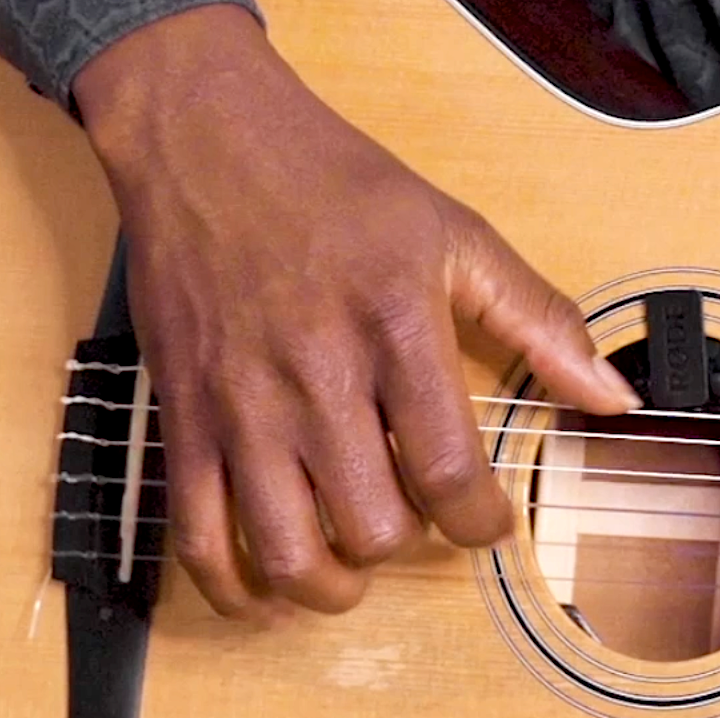
As for the fretting hand, you can see in the video that Tsumbu flows with extreme ease between chord positions. He achieves this by using minimal pressure when holding notes. Some shifts may feel awkward, which makes minimizing pressure a challenge, so be sure to break short passages down into bite-size repeatable chunks to allow yourself to focus on this one aspect.
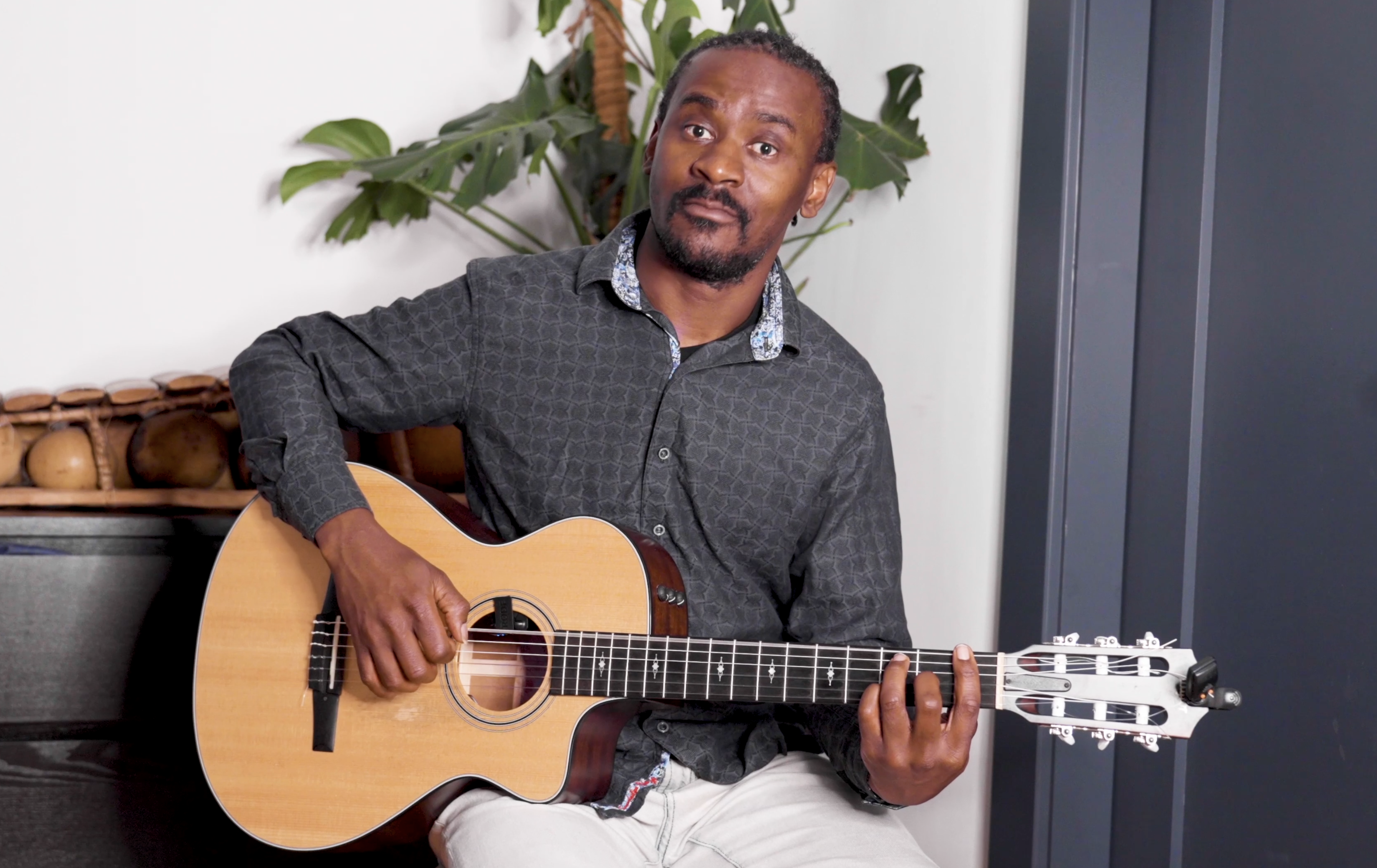
The examples
Example 1 - complimentary melody and bass in 12/8 time
While a 12/8 time signature was the simplest way to present this example, it could also be counted like alternating 4/4 and 2/4 bars. To get a feel for the syncopated rhythm, explore tapping it out with your hands, tapping the upper voice with the right hand and the lower voice with the left. The repeated picking patterns are rather intricate so be sure to practice slowly with a metronome sounding each main beat. Watch Niwel play this in the video below.

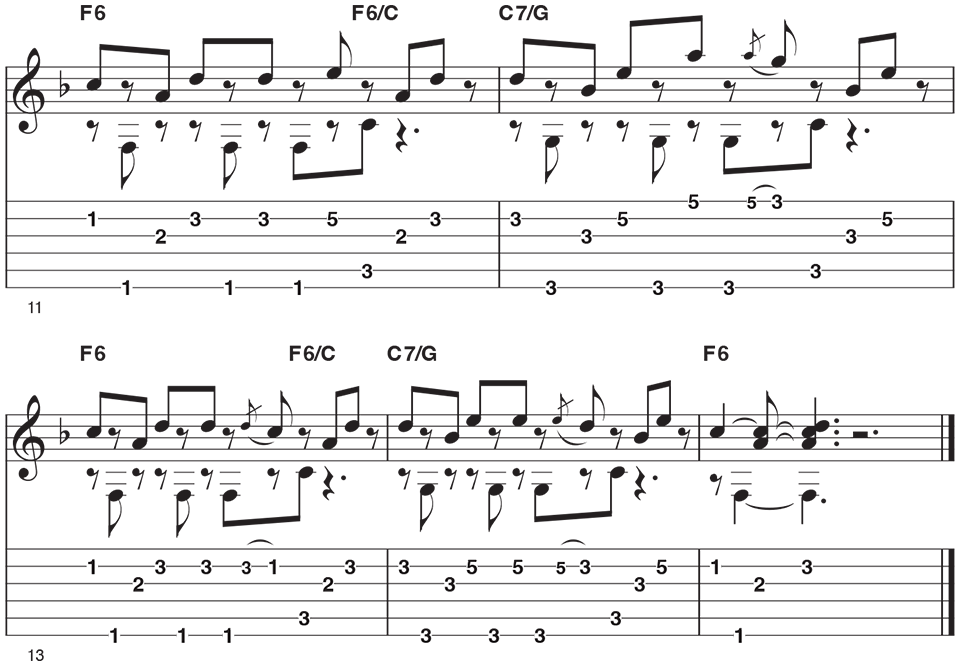
Example 2 upper and lower voicings in 7/8 time
This example in 7/8 time (7 eighth beats make up each bar) consists of ascending 8th notes with upper and lower voicings. The upper voice is the final three notes of each bar (the note stems are upward in the notation) and the lower voicing being the first four notes of each bar (these note stems are downward in the notation). Practice both voicings separately to get the best feel before joining them together. As with all the examples, listening and watching Niwel will greatly help how you interpret the tab and notation. See him play this in the video below.
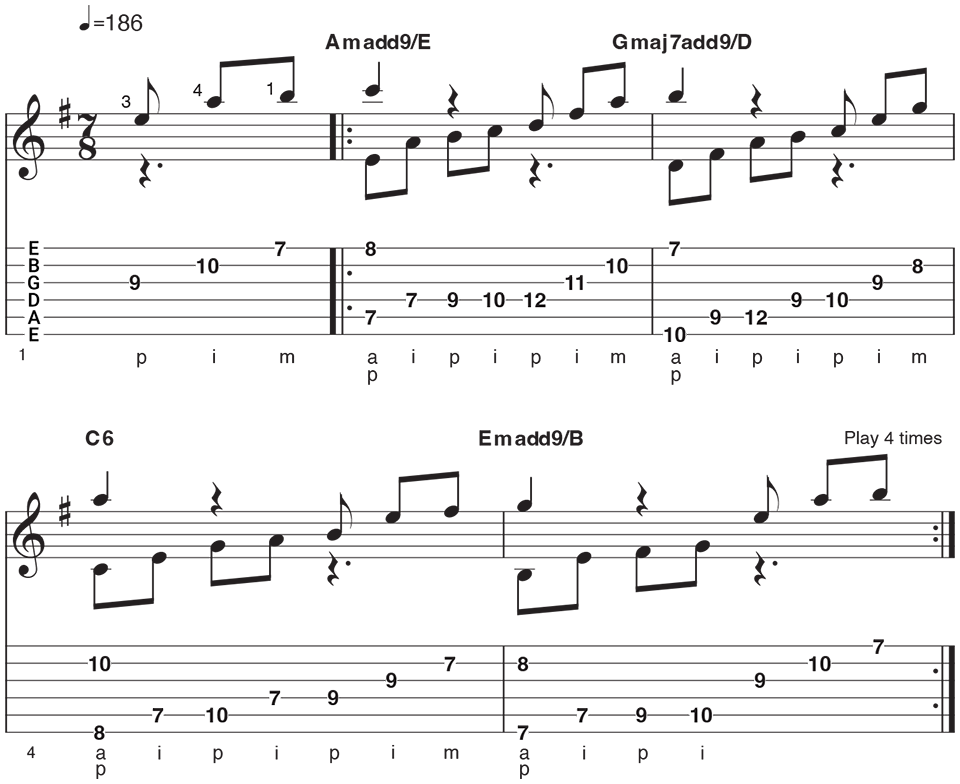
Example 3 - doublestops in 9/8 time
Here you have double-stops (two notes played together) played in 9/8 time (9 eighth beats in a bar) with the intervals being largely 3rds or 6ths, the two sweetest-sounding intervals in music. Practice the double-stops as single notes, choosing the upper or lower note each time. This way, you'll enhance their clarity when you combine the two and develop a deeper appreciation of the melodic content.
Use your fretting hand's first finger as an anchor when moving between positions, keeping a loose thumb behind the neck of the guitar. Pick the lower voicing with the thumb (p), keeping the first (i) and second (m) fingers alternating in the upper voicing. Watch Niwel play this in the video below.
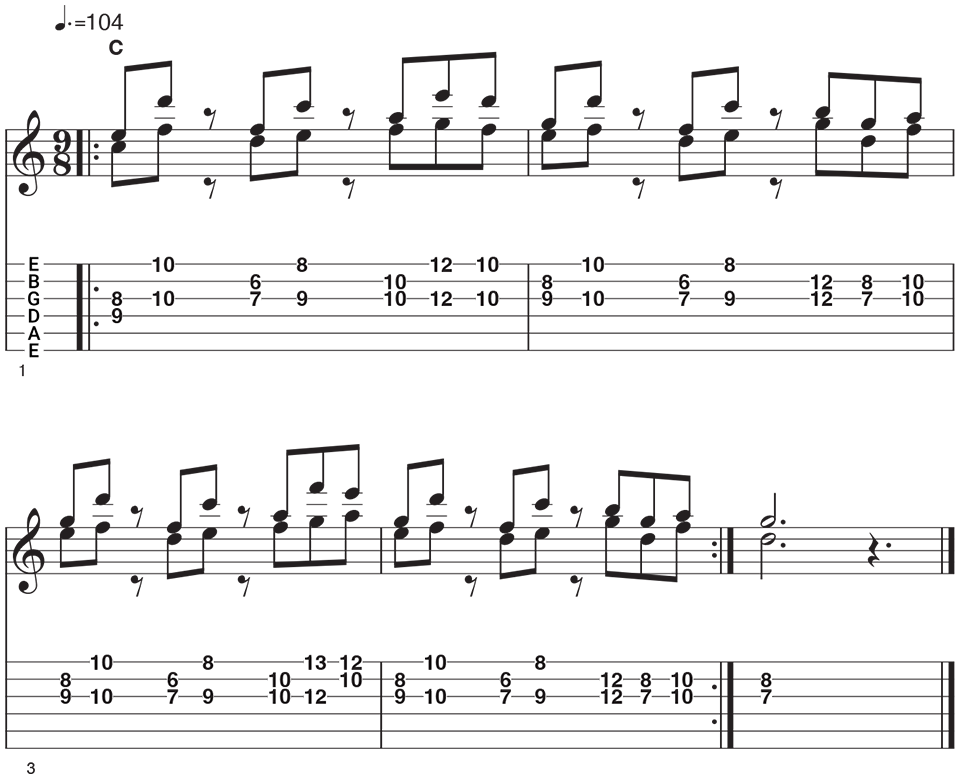
Example 4 - 10ths in 4/4 time
This has a 4/4 flow (four quarter beats to a bar) with an energetic rhythmic groove in the bass. Many of the double picked notes (e.g. bar 1, beat 1 - C and E notes) are 10th intervals: a third interval that is widened further by taking the 3rd up to the next octave. This is a very nice sound, common to guitaristic chord arpeggiating.
Maintain a stable picking hand position to keep the rhythmic groove consistent. Pick all lower voice notation with the thumb (p). Keep the melody lively by connecting all of the notes as legato as possible (played smoothly with sustain). Watch Niwel play this in the video below.
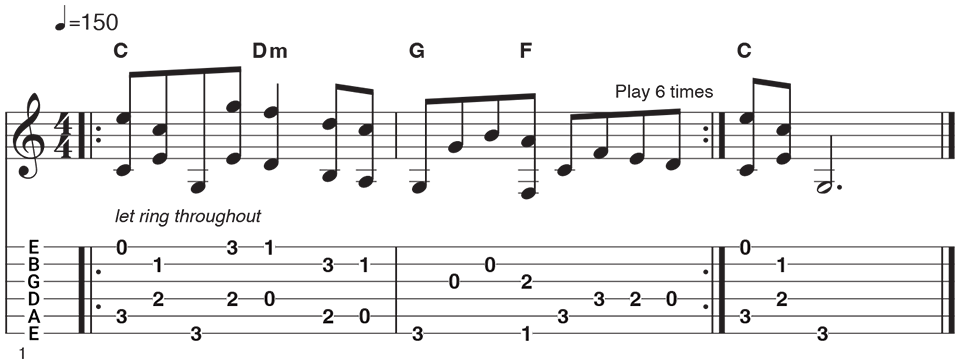
Example 5 - Ornate pull-offs in alternating 4/4 and 2/4 time
The snappy pull-off notes throughout this example are ear catching but can add tension to the fretting hand. Because of this, treat each pull-off instance as an exercise, practicing each one in isolation in three or four-note bursts, using a relaxed hand. Watch Niwel perform this below.
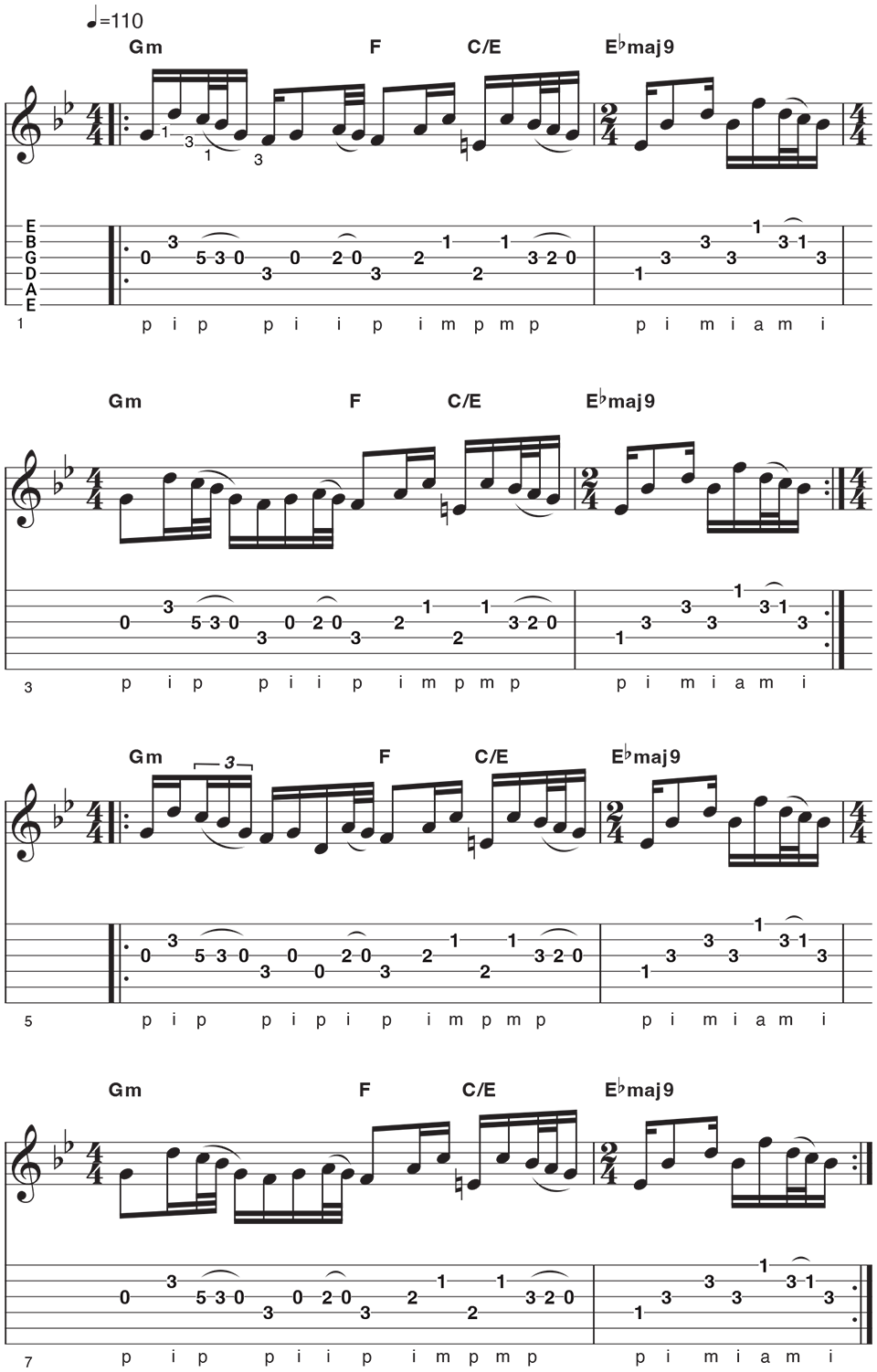
Niwel Tsumbu in action
Human Nature
This Michael Jackson song from the huge-selling Thriller album gets a wonderful solo guitar arrangement by Niwel here. He uses the fretboard well to cover the opening synth riff up high and then down to the lower frets to play chords and the vocal line. With a relaxed posture and intricate fingerpicking it's an excellent example of both his technique and musicianship.
Kanzenzenze
"Kanzenzenze" is a beautiful arrangement of a traditional African folk song. "It’s a song we’d sing as kids while playing a game," Niwel says. "You sit close to each other in line, pointing at your feet, singing while counting your feet with your fingers. Whoever the last note ends on, he or she is out."
Tears Of Joy
Niwel's tone and technical detail is to the foreground here with a piece that blends elements of world music, flamenco and jazz. Notice how clear his fretting hand pull-offs are alongside his fingerpicking chord fluidity.
Get The Pick Newsletter
All the latest guitar news, interviews, lessons, reviews, deals and more, direct to your inbox!
Niwel Tsumbu is a Congolese-born musician with a distinct musical voice on the acoustic guitar which he has described as a melting pot of styles, fusing Congolese folk with global popular styles like jazz, rumba, classical and pop, to name but a few.
Having settled in Ireland, Tsumbu has become celebrated for his collaborations with renowned artists like Sinead O’Connor, Glen Hansard, and the Crash Ensemble.
Further afield, Tsumbu’s collaborations include Buena Vista Social Club and American folk artist Rhiannon Giddens, landing Tsumbu appearances on Jimmy Kimmel Live and more. 2024 saw the release of Tsumbu’s first solo album, Milimo, which has received high praise from all corners of the jazz world.




